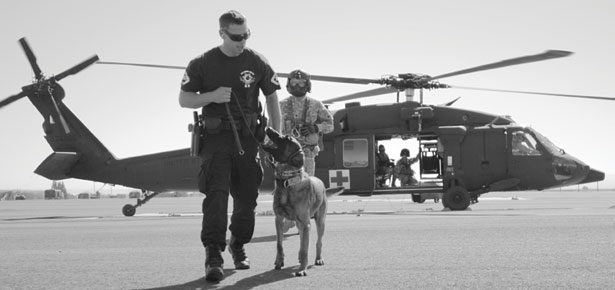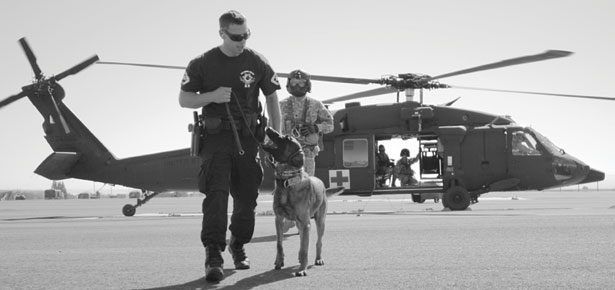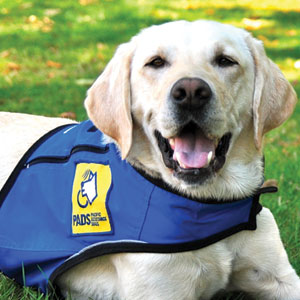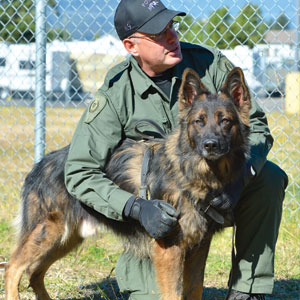

Crime-fighting Canines
The Canine-Officer Bond
January 23, 2006 was the worst day imaginable for Vancouver Police Dog Nitro. He was just months shy of retirement after an almost seven-year partnership with Vancouver Police Department dog handler and trainer Constable Howard Rutter, when the pair was called to assist in apprehending two occupants of a stolen car.
Police chased the vehicle from Vancouver, into neighbouring New Westminster where, ultimately, a moving train halted all traffic. The occupants exited the vehicle and began to run, first toward the train, then away.
Once they were about 100 yards away from the train, Rutter felt it was safe to release Nitro, but one suspect suddenly changed direction and headed back toward the train with Nitro in pursuit. The suspect jumped onto the side of a train car, hanging on, and Nitro jumped too, latching his teeth into the suspect’s leg. The suspect shook him off. Nitro fell to the ground then got up to continue the chase. That’s when he got clipped by the train and pulled underneath its moving wheels. Nitro was killed in the line of duty.
The loss was devastating for Rutter. “The dog is your partner. They are logged in as your partner in the computer system in the car,” says Rutter. Nitro, like all Vancouver Police dogs (and most police agency dogs), lived full-time with his handler and family. Rutter says he still misses Nitro, “the friendliest dog ever.” Though losing a police dog is rare, it has happened eight times since the Vancouver Police Department Dog Squad was formed in 1957.
The bond between officer and canine is an emotional attachment at odds with the reality that someday, the handler may have to put the dog in a situation where it may be hurt or killed, in order to protect the public or another officer.
“It’s an operational reality…but that doesn’t make it easier,” says Rutter. “You can’t make a tactically poor decision to save the dog. You can’t put yourself or others into danger. If you send your dog into a building and hear a gunshot and hear your dog yelp—if you run in after him, that’s a tactically poor decision. Now the guy will probably shoot you and if other police officers see you run in, they won’t let you go in alone. It’s a tactically poor decision to save the animal even if your first instinct says to do it.”
Rutter’s new dog, Blix, another male purebred German Shepherd, is working with Rutter training other handlers as well as performing as a general service dog. Police dogs are generally cross-trained, first in general service—tracking suspects, clearing buildings, recovering evidence, and criminal apprehension work—and then either in narcotics or firearms or explosives.
Since the dogs show the same passive alert when they find a target—they sit still—it is important that police officers reaching under a car seat know if they will find “a joint or a bomb. You need to know that. It’s kind of important.”
The primary reason that these crime-fighting canines can locate suspects or evidence, or tell the difference between a bomb and an empty knapsack, is their exceptional sense of smell. Police dogs can track a suspect whether he went up a tree or out of the area.
“Suspects crawl into crawl spaces where we wouldn’t find them; the dogs find that. In a busy urban environment they can find [a suspect] an hour after a crime has been committed, hours and up to a day in a rural environment,” says Rutter. “Sense of smell is the dog’s greatest asset, [that] and the speed at which they work. If there’s a high school B&E, it takes 20 minutes for the dog to clear it; six officers could take several hours.”
That’s because, says Officer Gregg Tawney, dogs following a scent don’t try to reason. They don’t try to rationalize whether or not a person could fit in a space or go in a certain direction. “The dog doesn’t use its eyes; it follows its nose.”
Tawney, an Elk Grove Police Officer in Northern California and Regional Trainer for Vigilant Canine Services International (VCSI), a K9 service provider for law enforcement, works with partner Rango, a male Malinois.
“Malinois make great soldiers and police dogs. They hunt and search until I put on the brakes. They won’t stop. It’s awesome for us,” says Tawney.
In fact, Tawney says that drive is one of the traits trainers look for.
“They need this drive to hunt, chase, and bite. Now you have to put control into that drive.”
For Tawney, everything while training is toy-related. Old-style training regimens used compulsive training, a type of negative reinforcement. Today, trainers have found using positive reinforcement gains the dogs cooperation faster and “when we both want the same thing, training is easier on both of us,” says Tawney. “It’s better if [the dog] views you as a fun and generous boss…I want the dog to try new behaviour without fear of being punished.”
Police dogs need to be healthy, of course, and able to work in any environment, including those with extreme temperatures, challenging ground cover, or loud noises, without hesitation or distraction. The dogs also have to be highly social, not dog-aggressive, and courageous. A typically day can include tracking a bad guy, then doing a canine demonstration at an elementary school.
“Not every dog is a police dog. [Even] if they’re bred for police work, [still] only 10 percent make it,” says Tawney, adding that the failed dogs often go on to make excellent working dogs in other fields, such as search and rescue or bomb-sniffing. There’s another great reason why police departments use dogs.
“Working with dogs provides a commonality people relate to,” says Tawney. This is especially helpful when children witness domestic violence and see the police removing their parents. “The great thing about the canine unit is they allow us to build relationships. Kids see us, not just the uniform. They see the dog and pet it. It’s a dialogue with me and a dog, not an officer. They see us as more human.”
It’s an aspect of police dog service that cannot be underestimated. Dogs calm people but also provide stronger motivation for surrender.
“Without a doubt, bad men are more fearful of the dog than the officer,” he says. “Professionally, I find more bad guys and evidence; there are more drugs and guns off the street because of my canine partner. The service they give to the community is tremendous. I think without a doubt many potentially violent confrontations are diverted because I have him with me.”
And yet, at other times, it’s just a dog, sitting there doing nothing, that counts for the most.
B.C.’s Delta Police uses a trauma dog in its Victim Services section. The dog won’t catch a killer, but will help get people comfortable with aspects of an investigation. Crime fighting comes in many forms.
Its trauma dog, Caber, is a five-year-old yellow Labrador Retriever that surely would have flunked out of police dog school. He is so laid back, he once fell asleep at a presentation and rolled off the stage.
“He is extremely low energy,” says Delta Police Victim Services’ civilian handler and Program Coordinator Kim Gramlich. “He’s as soft as a dog gets. He provides support services to victims of crime and trauma. We reference him as a different type of police dog.” Just as general service dogs can find scents and people that an officer couldn’t, Caber the trauma dog can provide a special type of comfort that a person could not.
Such was the case several years ago following a horrific incident that rocked the community. On Saturday, September 25, 2010, a stranger brutally attacked local 15-year-old high school student Laura Szendrei on a Delta, BC, park trail in broad daylight; Szendrei later died in hospital. Students were set to return to school the following Tuesday, and parents, teachers, and community leaders wondered how to help students cope with the fact that Laura would not be there amongst her friends.
Caber showed up to murdered girl’s first class and sat next to her empty desk. Students reacted and poured attention onto Caber. At each class break as students shuffled to their next class, there would be Caber sitting next to Laura’s empty desk. The scene repeated itself over and over that day.
No human being could ever have offered what Caber did at Laura’s school. But for Caber, like for every other police dog, it was all in a day’s work.
Join the newsletter and never miss out on dog content again!
"*" indicates required fields
By clicking the arrow, you agree to our web Terms of Use and Privacy & Cookie Policy. Easy unsubscribe links are provided in every email.

